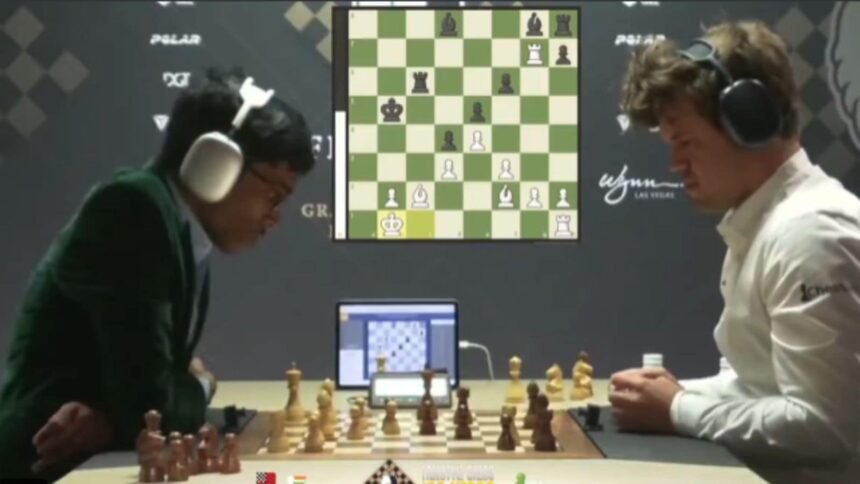India’s R Praggnanandhaa defeated world number one Magnus Carlsen at the Freestyle Grand Slam Tour’s Las Vegas leg last night. Pragg, playing with white pieces, defeated the world number one in 39 moves. At the end of the day, Praggnanandhaa topped Group White to qualify for the quarterfinals while Carlsen lost a close battle to Levon Aronian to be knocked out of the race for qualifying for the Winners’s Bracket.
Carlsen will still be competing in the tournament, but only in the Losers’ bracket, which means he can, at best, end up third and cannot win the event.
Carlsen started his event at Las Vegas with two wins but then slumped to losses against Praggnanandhaa and Wesley So. Then there were two draws, which left him needing a win in the final round just to force a tiebreak. He beat Bibisara Assaubayeva. But then lost both playoff games to Aronian, who clinched the final qualifying spot from the White Group.
The group stage, which saw the participants play seven rounds of 10+10 games in two groups of eight players, opened the fourth leg of the 2025 Freestyle Chess Grand Slam.
INTERACTIVE: How Praggnanandhaa defeated Magnus Carlsen
Praggnanandhaa had famously defeated Carlsen in the classical format at the Norway Chess tournament in 2023. Before that, he had defeated the Norwegian in an online game.
The emphatic performance from Pragg has come after a disappointing performance at the Paris leg, where he finished in ninth place. Carlsen, on the other hand, leads the overall ranking of the Grand Slam Tour as he won the earlier legs at Karlsruhe and Paris, and he finished third in Weissenhaus, Germany.
Freestyle Chess Grand Slam Tour is a series of multiple chess events around the year, modelled on the grand Slams in tennis started by Germany’s Jan Henric Buettner. In 2025, it was initially supposed to be held in cities like Weissenhaus, Paris, New York, New Delhi and Cape Town. But the New York event was shifted to Las Vegas while the India event was cancelled.
Story continues below this ad
What is Freestyle chess
Freestyle chess is a variant of chess that was popularised by the legendary Bobby Fischer way back in 1996. It’s chess with a twist.
In regular chess, positions of chess pieces on the back ranks are fixed: the rooks are stationed on the corners, the knights start on the b and g files, the bishops on the c and f files. Both kings are on e file squares while the queens start on d squares.
But in freestyle chess, the positions of these pieces are randomised at the start of the game, although the eight pawns in front of these pieces start where they usually do. This format is meant to promote creativity from players. The unique opening position in each game eliminates all the opening theories which players like Fischer and Carlsen say make chess very theoretic and bookish in the first phase.
Players are forced to navigate uncharted territory from the first move itself rather than having the luxury of playing out the first series of moves based on preparation cooked by their team. In total, there are 960 possible starting positions on the board when the minor and major pieces at the back ranks are shuffled.
Story continues below this ad
It must be noted that the pieces still retain their regular characteristics in action: rooks move in straight lines, bishops cut across the board in sweeping diagonal movements, and the knights make sickle-like veering motions and retain the ability to hop over pieces.
Over the years, freestyle chess has earned many names: Fischer Random Chess, Chess 9LX and Chess 960.








